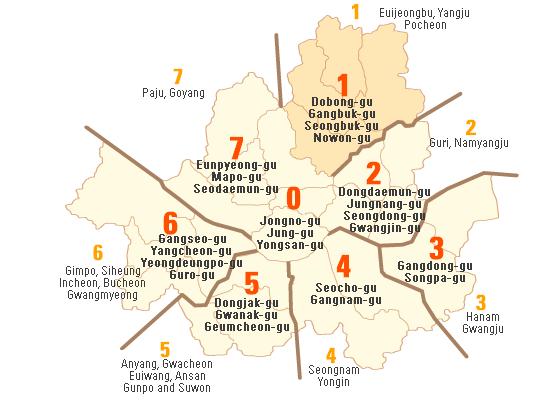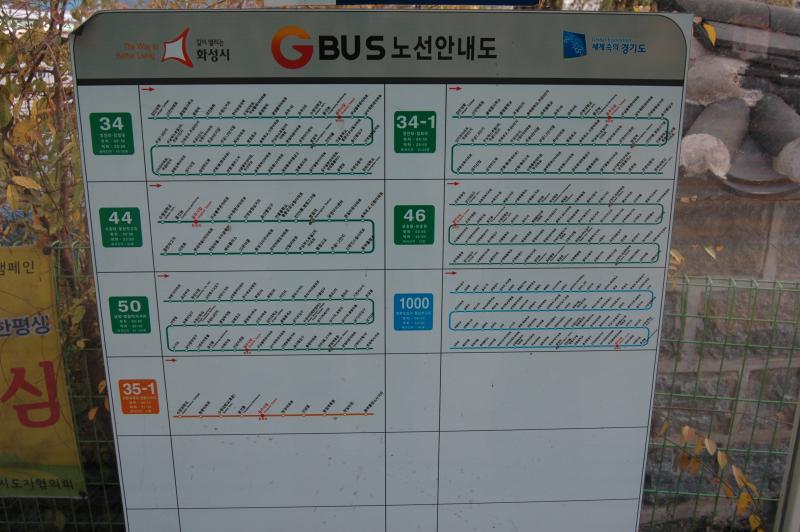A reader named J.L. writes in asking about buses:
Hello Chris. I’ve been here for about 5 months with my Husband in [city redacted]. I was wondering if you had any websites that explain what busses to take to go to certain places? the 20 bus that takes us to Pyeongtaek Station//AK Plaza but I don’t know what busses to take from there to get to other places. I just mean city busses not the shuttle busses. I tried looking on a website I found on google but it wasn’t much help and didn’t tell me what busses go where. Thank you very much! Hope you can help!
[J.L.]
Hi J.L.
Ahh, the buses – one of the best ways of getting around once you figure them out. If you’re in Seoul, the most commonly referred website is this Congamul interactive map. Personally, I’m not a big fan – it’s slow, buggy, requires a plug-in, and only works in Internet Explorer. Google Maps works better with plain-English search terms, and is probably familiar to you already.
Where using the subways requires knowing where to transfer or when to get off, buses require a bit of geographical knowledge. When you see a certain place, it helps to know if that’s north, south, east, or west to where you want to go. This, of course, tends to come with experience.
Photo credit: Visit Korea
Around Seoul, the blue bus route numbers are based on the first and last stops the bus makes. For example, take bus number 101. That bus route’s first stop is somewhere in zone 1 (northern Seoul) and winds its way down to zone 0 (downtown Seoul). That last digit is there to keep it unique; bus 102 also starts in zone 1 and ends in zone 0, as does 103, 104, etc.
Green buses and red buses in Seoul have a similar numbering system – the first two digits indicate the first and last stop zones, just like the blue buses. The last two numbers are the serial number, just like the last one of the blue buses. Other cities and counties across Korea have their own systems.
Um, ok – so how does that help me get to the local what’s-it-called?
If you prefer the techie solution, I’d start with Visit Korea’s traffic website. You can view information about every bus that runs through Seoul, Gyeonggi-do, and Incheon. Starting with the buses that stop in your area, look up the numbered routes and see where they go.
If you prefer the note-taking solution, keep some paper with you whenever you travel. As you travel, note which buses stop at the places you frequent. Once you’ve collected some information, cross-reference the list and make some matches. For example, you know bus 20 stops at Pyeongtaek Station/AK Plaza and at Pyeongtaek City Hall. When I lived in southern Seoul, I knew I could catch bus 462 to get from my apartment to the Lady in Red’s old apartment. Keep the notes however you like – the Lady in Red keeps a note on her iPod Touch for reference wherever she goes.
If you prefer the exploring kind, just hop on a bus and see where it takes you. Keep your eyes on the bus map or out the window – if you want to turn around, get off, cross the street, and get the same bus going the other way. This is actually a fun way to explore an area, or see what’s around you. If all else fails, catch another bus or a taxi back to a known landmark and work your way home from there.
Reading the bus routes
It’s sort of a fine art reading the bus routes. On one hand, some bus routes stop at subway stations, while others have more twists and turns than a curly wig. Some route signs feature English bus names, while others are entirely in Korean. There’s not a lot of consistency, and not always a lot of help for the foreigners. While Seoul buses typically have English audio announcements, you can’t always count on them outside the capital city. Learning to read Korean – and getting to know the lay of the land – will definitely help you ride the buses with confidence.
Calling for help
One solution is to call 1330 (the government-sponsored tourism hotline) or 120 (the government-sponsored ‘life-in-Korea’ hotline – press 9 to get an English speaker). Ask them how to get from point A to point B, and they’ll tell you if a bus connects those two points. They’re also decent for those classic ‘how do I get to…?’ type questions.
Readers – how did you figure your way around the buses?
This post was originally published on my blog,Chris in South Korea. If you are reading this on another website and there is no linkback or credit given, you are reading an UNAUTHORIZED FEED.
This post was originally published on my blog,Chris in South Korea. If you are reading this on another website and there is no linkback or credit given, you are reading an UNAUTHORIZED FEED.







 RSS Feed
RSS Feed
Recent comments